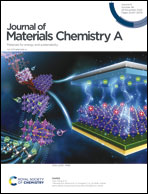Layered hydrotalcite derived holey porous cobalt oxide nanosheets coated with nitrogen-doped carbon for high-mass-loading Li-ion storage†
Abstract
Nanosized 2D transition metal oxides (TMOs) are promising electrode materials for Li-ion batteries (LIBs) due to their theoretical high capacity, large specific surface area, and abundant active sites. However, they suffer from low conductivity and huge volume variation upon cycling. They also pose big experimental difficulties to realize areal capacities that are higher than that of commercial graphite (∼4 mA h cm−2). Here we propose a novel strategy to prepare holey porous CoO (HPCO) nanosheets through annealing layered cobalt hydrotalcites followed by coating a thin layer (∼10 nm) of nitrogen-doped carbon (NC). The resulting HPCO@NC nanohybrids deliver a good synergistic effect in addressing the abovementioned issues. Microscopically, the compositional and morphological integration of HPCO and NC equips the nanohybrids with continuous channels for both Li ions and electrons and with sufficient structural flexibility to accommodate the volume change. Macroscopically, the in-plane holey structure creates interconnected pathways in the thick electrode, thereby addressing the sluggish Li-ion diffusion kinetics at high mass loadings. As a result, the HPCO@NC nanohybrids deliver a high areal capacity of up to 7.1 mA h cm−2 at a high mass loading of 10 mg cm−2. This strategy may pave the way to realize the practical implementation of 2D TMOs towards next-generation LIB anode materials.



 Please wait while we load your content...
Please wait while we load your content...